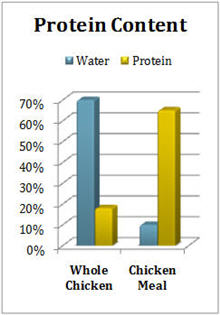How to Read an Ingredient List
When it comes to choosing the right food for your pets, there seem to be infinite options. Because every pet is unique in their needs, the pet food industry is, like our pets, incredibly diverse. At Bend Pet Express, we know that nutrition is an essential element to your pets’ health and happiness.
But, even though we all want what’s best for our pets, the amount of options and specialized marketing found in the pet food industry can make it challenging to make the right choice. Some foods are said to be specially crafted for a certain type of animal, while others promise cures to various health ailments. How do you make the right choice, with so many choices to make? It can be tough, and Bend Pet Express is here to help!
Government regulations on pet food require that nutritional labels provide specific pieces of information. One of the most important is the ingredient list.
The Short and Sweet of It
An ingredient list is an ordered list of everything in your pet’s food organized by decreasing pre-cooked weight.
A super simple rule of thumb is the easier it is to read, the easier it is to digest. Same goes for length of the list; shorter is mostly better.
The order of ingredients in the list can be a bit misleading through the practice of ingredient fractioning.
The Basics
When it comes down to it, the ingredient list is what it is — a list of the ingredients in your pet’s food. The ingredients are listed in order of decreasing pre-cooked weight, which means first ingredient is going to be the most prevalent, while the last ingredient will be the least. Pretty simple!
You will almost always see a meat protein as the first ingredient, followed by some grains or legumes. After that, things may start to get more complicated, and you might find some “hard to read” ingredients.
Here’s an example ingredient list for discussion:
Chicken, Burbank Potato, Norkotah Potato, Chicken Meal, Chicken Fat (Mixed Tocopherols), Whole Blueberries, Potassium Chloride, DL–Methionine, Choline Chloride, Calcium Propionate,Minerals: Zinc Proteinate, Iron Proteinate, Manganese Proteinate, Copper Proteinate, Iodine, Cobalt Carbonate, Selenium Yeast,Vitamins: Vitamin E Supplement, Riboflavin, Niacin, D-pantothenic Acid, Thiamine hydrochloride, Vitamin A Supplement, Pyridoxine Hydrochloride, Biotin, Folic Acid, Vitamin B12 Supplement, Vitamin D3 Supplement,Yeast Extract, Glucosamine Hydrochloride
Chicken is first and foremost followed by potatoes, chicken meal, whole blueberries, and lots of big, chemical-sounding words. However, even though food with fewer ingredients is generally easier to digest, the presence of the chemical ingredients does not necessarily make the food unhealthy — they are often added to make the food more complete nutritionally.
A Chicken by Any Other Name
In the sample list, chicken as the first ingredient, which is fairly standard — as previously mentioned, having a meat protein as the first ingredient is common for dog food. However, when using meat as a protein source, the kibble will generally have a moisture content around 10%, meaning that the food must be held together somehow.
Enter chicken meal! The term “Chicken meal” is actually a controlled term defined by AAFCO and it reads as follows:
…the dry rendered product from a combination of clean chicken flesh and skin with or without accompanying bone, derived from whole carcasses of chicken, exclusive of feathers, heads, feat and entrails.
The chart below from the amazing dogfoodadvisor.com website shows us two things; just how much moisture is in raw chicken and the density of nutrients in chicken meal.

So we get all the great parts of the chicken and none of the parts we don’t want all ground up and dried out. Seeing as moisture loss in meal isn’t an issue we would not see the same drop down the list like we saw with the actual meat.
The takeaway? Chicken is awesome and Chicken meal is even more awesome.
Fractioning
Fractioning is another potential way to manipulate what appears first on the ingredient list in your pet’s food. Let’s review the top of the example list:
Chicken, Burbank Potato, Norkotah Potato, Chicken Meal
The ordering of the list gives the impression that the potatoes are broken up by variety, which is neat if you’re really interested in exactly which type of potato Biscuit is eating, but it also hides the fact that the total amount of potato in this food is unusually high. In fact, if you combined ingredients, it might even change the order of the list to simply “potato, chicken.”
This example is not particularly offensive. Potato is already ingredient 2 and 3 on the list so we know there are a lot of potatoes here. It gets increasingly difficult to swallow when we see something like “green lentils, peas, pea flour, pea starch, red lentils, etc.” This is the most common type of fractioning — using different “forms” of the same ingredient to make it appear less prevalent in your pet’s food.
So why is fractioning such a common practice? Mostly because consumers are learning constantly, and many know that dogs and cats, which are carnivores, should be eating primarily meat. Fractioning gives food manufacturers the ability to convince pet owners that their food is made up of different stuff than what it’s really made of.
Vitamins & Probiotics
It is incredibly important that your dog food states “Complete & Balanced” somewhere on the bag. “Complete and balanced” food contains the correct amount of vitamins and minerals that will allow your pet to maintain their health while also maintaining a consistent diet.
Higher quality companies will be willing to spring for higher quality minerals, which are notoriously hard to digest, to gain better bioavailability. The higher quality minerals are called Chelated minerals. They are minerals whose structure has been bonded with something to allow better success with the bodies absorption rate. Look for the word ‘proteinate’ following the mineral or ‘chelated’ before the mineral as these are the two most common methods of informing you they are “chelated minerals”.
Probiotics vs prebiotics is a big discussion, and one that probably merits its own blog post. However, don’t pass up on a great pet food because they don’t have any probiotics listed. Adding some in supplemental form is easy, and in some cases, the best way to make sure your pet is gaining the benefits of probiotics.
Items on your ingredient panel that end in ‘bacillus’ or contain ‘coccus’, ‘bacterium’, ‘fermentation’ amongst others are “probiotics”, which contain bacteria that contribute to the health of your pet’s digestive system.
Items listed as ‘chicory root extract’, ‘inulin’, ‘oligofructose’, and ‘fructooligosaccharides’ (FOS) are some examples of “prebiotics”. Think of this as the healthy food to feed all that good bacteria in the gut.
Shorter is Better
We have mentioned a couple times now that in general a shorter ingredient list is often a better one. This isn’t always the case but when we counted the number of ingredients in each of the foods we carry here in the store we found that kibble had the highest median value at 37. That means each bag of food will have close to 37 different ingredients in it.
The median number of ingredients in our frozen raw products? 22.
How is that possible? Cooking reduces the nutrient density of that food and a vitamin pack is often reintroduced so that the food can meet the AAFCO standards. No cooking, no huge words.
Coming up for Air
There are certainly things that you should watch out for when it comes to ingredient lists, like the process of fractioning and the presence of chemicals in your pets’ food. However, despite some potential flaws, the ingredient list is still a valuable tool for determining what food you should feed your pets, and certainly isn’t anything to be nervous about!
And, even if you are anxious about choosing the right food for your pet, Bend Pet Express is always here to help. Please call, email or stop in to our Eastside and Westside locations and let us know what we can do to help you out. We have carefully researched the food we carry, and can provide everything from food to mix-ins and toppers to improve the taste and nutritional value of your pets’ kibble.
Often the first step in improving your kibble is to add some awesome toppers. Ease and flexibility of kibble but still a nutritional improvement for your pet. We offer quite a few and you can order online and pickup in store!

